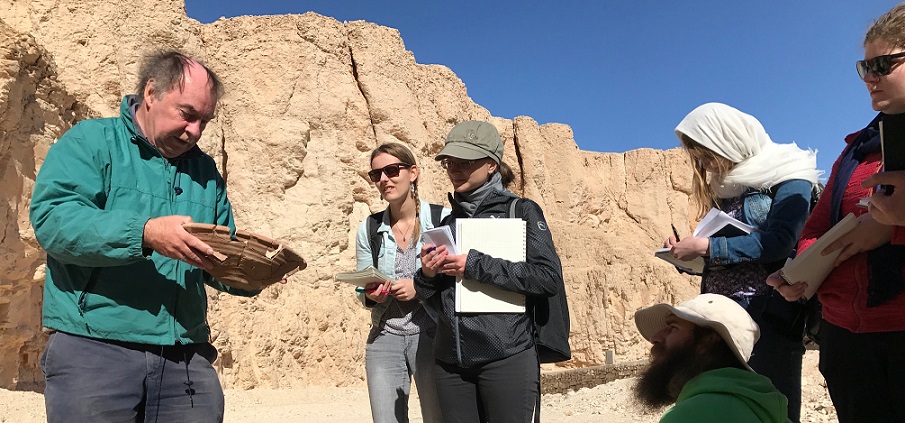Week 3: 21-27 January 2018
This week started out calmly, with most of the first day spent in the various institutions in Cairo that house an Egyptological library, the DAIK (Deutsches Archäologisches Institut Kairo) being the most frequently visited. In the afternoon Marleen gave a seminar on the site of Deir al-Barsha (in Middle Egypt), and, as a side note, explained how one can confirm scientific theories by making a mummy mask for a Leuven professor.
The next day, Monday, was rather a busy day, as we had Dahshur and Memphis/Mit Rahina planned during the day, and a lecture by Irene Forstner-Müller on the recent fieldwork at Kom Ombo in the evening. On the topic of Dahshur, I do not want the spectre of Sneferu to put an everlasting curse on me, so I will be nice about the Red Pyramid, the only one of his three pyramids we entered so far. Architecturally, it is a fascinating place, with its entrance shaft, the huge corbelled vault and the burial chamber. Nobody failed to be overawed by its general features. The omnipresent smell of bat shit, humidity, lack of any kind of air flow, and tiny entrances aside, I wholeheartedly recommend it to anyone.

Tuesday was a wholly relaxing day, as we had nothing planned except for going to the library. In the evening, some of us went to the opera. The dress code was eveningwear, and therefore wearing a bow-tie was mandatory. Curiously, instead of simply bringing a bow-tie, many people showed up without one, and borrowed a bow-tie from the opera house in exchange for a legal document of choice. The fact that this is far from practical did not seem to bother anyone.
Wednesday again was a quiet day, and was spent doing research, mostly preparing for the upcoming site presentations and visiting a lecture on the tomb of Harwa in the evening.
The twenty-fifth of January is somewhat of a special day in Egypt. Formally, it is the day of the police, but, since the 2011 revolution started on this date, it is now the celebration of that revolution. One was advised to stay at home, as everything would be closed anyway. Germans being Germans, their institute maintained its regular opening hours.

Friday was spent in preparation of the 10-day trip to Luxor. The night train we took in the evening was a new experience for most of us, and we were pleasantly surprised to find the beds comfortable, the butler (yes, there was a butler, with a tie and waistcoat and everything) friendly, and the views splendid. The night itself was rather uneventful, besides some of us trying to do yoga in the (tiny) corridor, getting stared at, and, as a result, quickly ceasing all such activities.
The next day, after having checked in to the Nile Valley Hotel on the west bank, we went straight on to the Valley of the Kings, where Susanne Bickel explained the reuse of tombs TT40 and 64, and David Aston made us all realize how useful pottery is, and that it actually can be fun once you get to work with it. Next we visited the tomb of Ramses X, after which we went on to Seti I, which hosts the only attested depiction of a praying mantis in all of Ancient Egyptian art. Subsequently, we visited the tomb of Ramses V-VI, which also had interesting features; for instance a monkey with a stick could be seen standing on a barque while hitting a pig in the presence of Osiris. We also visited the tombs of Tutankhamun and Merenptah. But the day was not yet over, for we also visited the Valley of the Queens, specifically the tombs of Khaemwaset (no, not that one), Titi and Amonherkhepeshef, All of this proved to be an exiting start to the Luxor experience.
Philip McLaughlin


